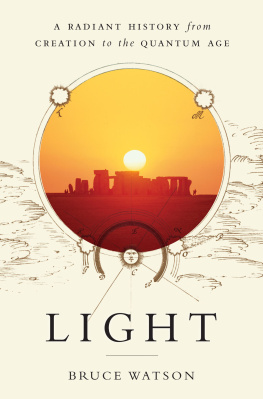Sky in a Bottle
Sky in a Bottle
Peter Pesic




For Andrei and Alexei
One of these mornings You're going to rise up singing Then you'll spread your wings And you'll take to the sky
Contents
Introduction
Imagine a summer afternoon with a serene sky. Its color is subtly variable, at times azure or almost indigo. But why is the sky blue?
Though a child could pose this question, it also puzzled Plato, Leonardo, and even Newton, who unlocked so many other secrets. Centuries passed; the question remained unresolved. As late as 1862, Sir John Herschel listed the color and polarization of skylight as "the two great standing enigmas of meteorology."' Solving these mysteries required powers of deduction that would have taxed Sherlock Holmes. Like a compelling detective story, this tale has many curious turns and surprises. The clues seem simple, but they force us to reexamine what seems obvious. The characters include some remarkable human beings. The identity of the culprit is especially revealing. What is more, the story is not over; we still do not fully understand why we see the sky as we do.
Best of all, the mystery is in the very air around us. Trying to deal with its elusive subtlety leads to a further question: Can we put the sky in a bottle? That is: Can we recreate that blue on earth, not just contemplate it in the vast expanse of the atmosphere? If we could bottle the sky, we might understand its blueness, as if now the prime suspect were our captive, subject to probing interrogation. This new perspective invites us to consider other mysteries, especially why the night sky is as dark (or bright) as it is.
The quest to put the sky in a bottle led to important realizations. I will try to present some new insights, as well as give new expression to others that call for restatement. I have tried to make this story as accessible as possible, with references and additional technical or mathematical notes at the end of the book, to help those who wish to go further. My goal was to bring the deep underlying questions to light in a thoughtful and faithful way, without oversimplification. Thus, I hope that this book can be read both as an engrossing tale and as a serious history. For those who would like to try some simple experiments, the text will refer to relevant passages in appendix A. Appendix B contains several hitherto unpublished letters between some of the protagonists.
Each episode in this story contains its own special grain of truth, fascinating in its own right, not merely as a tale of anticipations and false starts but of thought working in extremis. The cast of characters is large, though some will take the stage only for a moment. Though I will offer some human detail for a few personages, I could not do so for all without hindering the larger narrative, whose protagonist is not a person but a question. Such a story has a special dynamic that is human but also something more.
The quest to understand the blue sky and put it in a bottle opens larger perspectives, both scientific and humanistic. The color and brightness of the sky touches the secrets of matter and light, the scope of the universe in space and time, the destiny of the earth, and deep human feelings.
1 Out of the Blue
A mystery must emerge before it can be solved. Thousands of years may have passed before someone wondered about the sky's color. Questions tend to accumulate more around unfamiliar, strange happenings than around the everyday and ordinary. Yet unasked questions also point to fundamental beliefs and prohibitions.
Though their civilizations were very different, both ancient Greece and China tended not to speak about the sky's color. In the ancient Chinese Book of Songs (Shi ling), the phrase cang tian denotes vast or azure heaven, the overarching and immense vault of the sky and by implication the Power ruling it. The songs address the sky with yearning, calling to a realm far above human suffering, as in this lament over the old capital of the state of Zhou and the king who lost it:
Blue Heaven far, far above me,
What kind of man is he?'
Here, the impassive remoteness of the blue sky contrasts with human suffering and loneliness.
For the ancient Greeks and Chinese, azure had distinctly inhuman connotations, because death changes the healthy red color of the body to an unearthly blue, cyanosis. At Fengdu, in the main gorge of the Yangzi river, stands a temple reputed by Taoist tradition to be the gate of Hell, the entrance to the afterlife that must be traversed by dead souls.' The gates are painted a garish sky blue, not to be touched by the living, at peril of premature death. In contrast, yellow was the imperial color, reserved for the emperor's use, and red the color of life and celebration, used even today for marriages. Yet in India the divinities were often portrayed with dark blue skins and the poet Kalidasa celebrated a sky "as dark blue as a sword."'
Purple was the imperial color of Rome, but blue was definitely the color of the barbarians. The ancient Britons dyed their bodies blue, a frightening sight to enemies who associated this color with death; the Roman historian Tacitus described the blue-daubed Britons' "spectral army." British women injected blue dye beneath the skin. In contrast, the Romans wore blue to denote mourning and considered blue eyes a kind of deformity, a sign of bad character, a barbarian trait.' Likewise, in the Qur'an demons have blue eyes, denoting their evil, infidel nature. According to the twelfth-century Persian poet Farid ud-din Muhammad Attar, "heaven bears the blue color of sorrow as a sign of mourning that it has not attained the goal of its search to know the essence of God."s
For the ancients, the heavenly realm was divine. Because of its superlative power, the sacred could be dangerous, hence better left unuttered. If so, it would be better not to name the sky's color or touch its alien power. Recounting the Greek creation stories, Hesiod tells that Sky (Ouranos) was the first child of Earth, "equal in size with herself, to cover her on all sides."' The poet Aeschylus tells that "pure sky [Ouranos] desires to penetrate the earth, and the earth is filled with love so that she longs for blissful union with the sky. The rain falling from the beautiful sky impregnates the earth, so that she give birth to plants and grain for beasts and men."' Among the descendants of this primal union was the high god Zeus, dwelling in the sky with the other Olympian gods. The deities identified with the earth stood apart from those of the sky.
Even now, heaven connotes a divine realm radically different from earth, whereas sky is a more neutral term. Modern science turned heaven into sky and then atmosphere. Yet we continue to refer to "the heavens," showing how deeply rooted is the ancient conception. The Greeks contrasted the heavens, ouranos, with what they called physis, a realm of growth and change extending between the earth and the moon. Our word "physics" typically refers to inanimate matter, but the Greek word phyein means to grow and change as living organisms do. Though we moderns characteristically think of the earth as just another planet in space, the Greek words ouranos and physis indicated utterly different realms. Of the two, ouranos was nobler, the realm of celestial, immortal bodies. Physis is the mortal realm where we are born, grow, and die.















